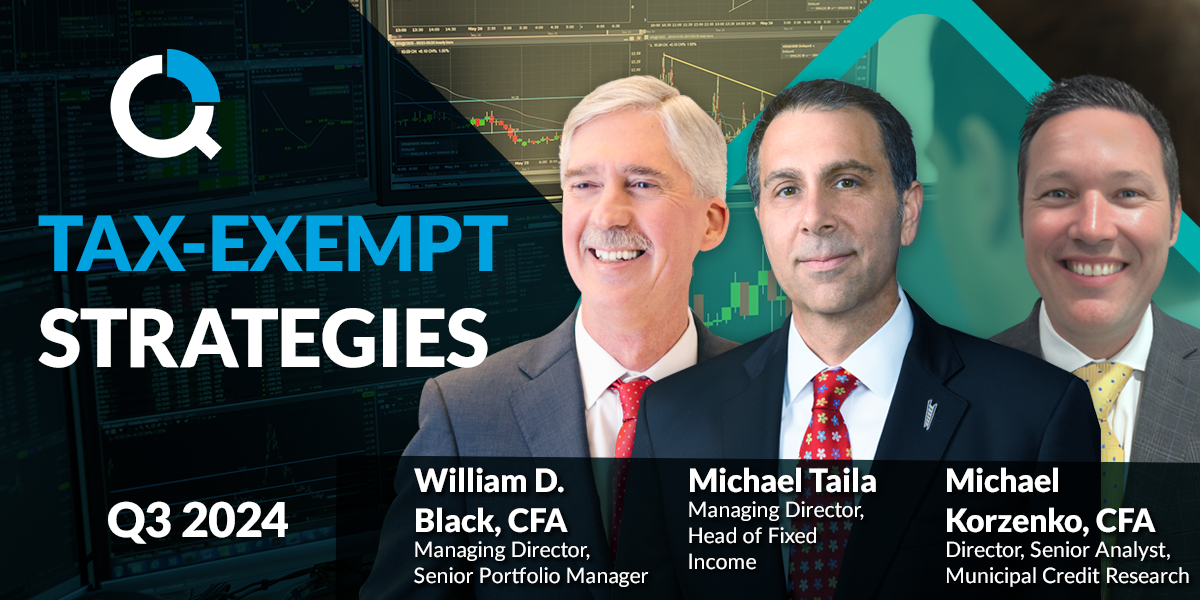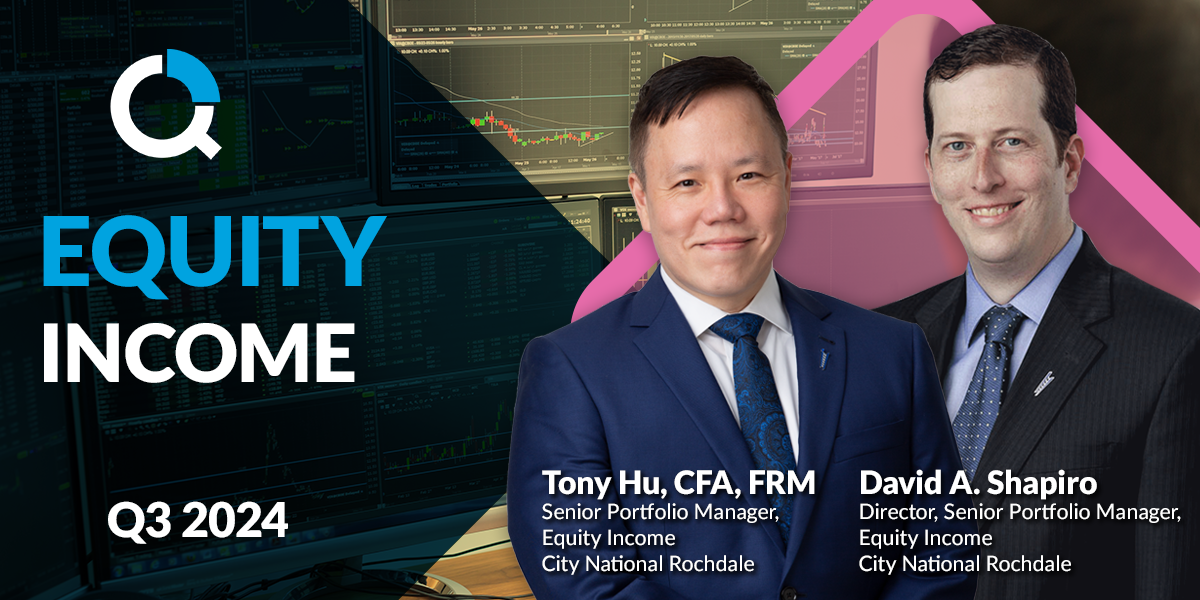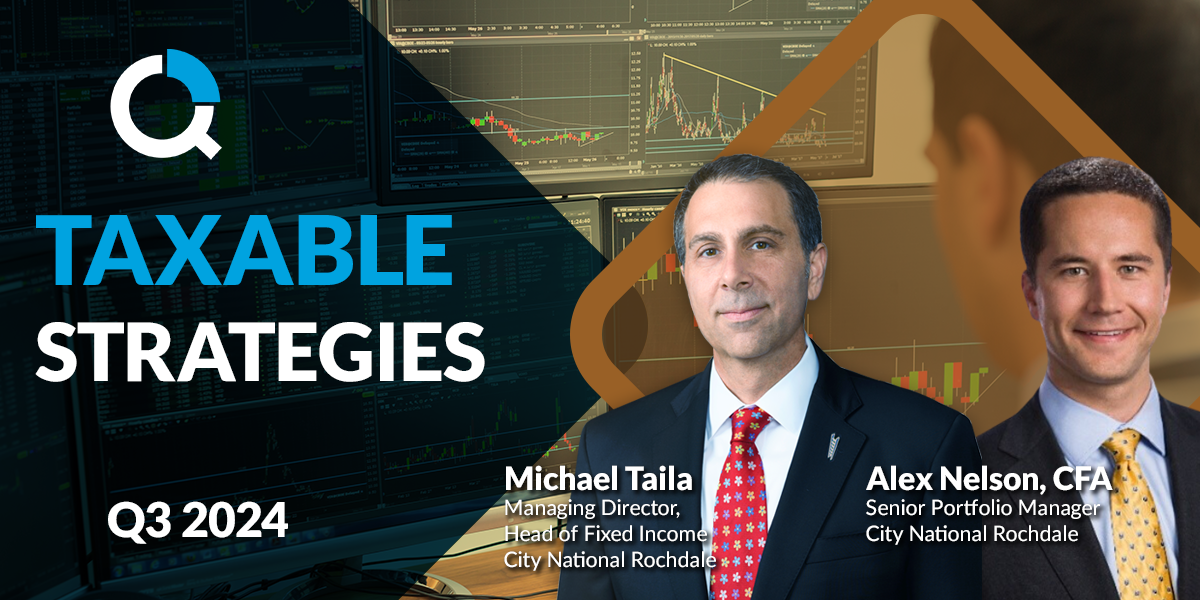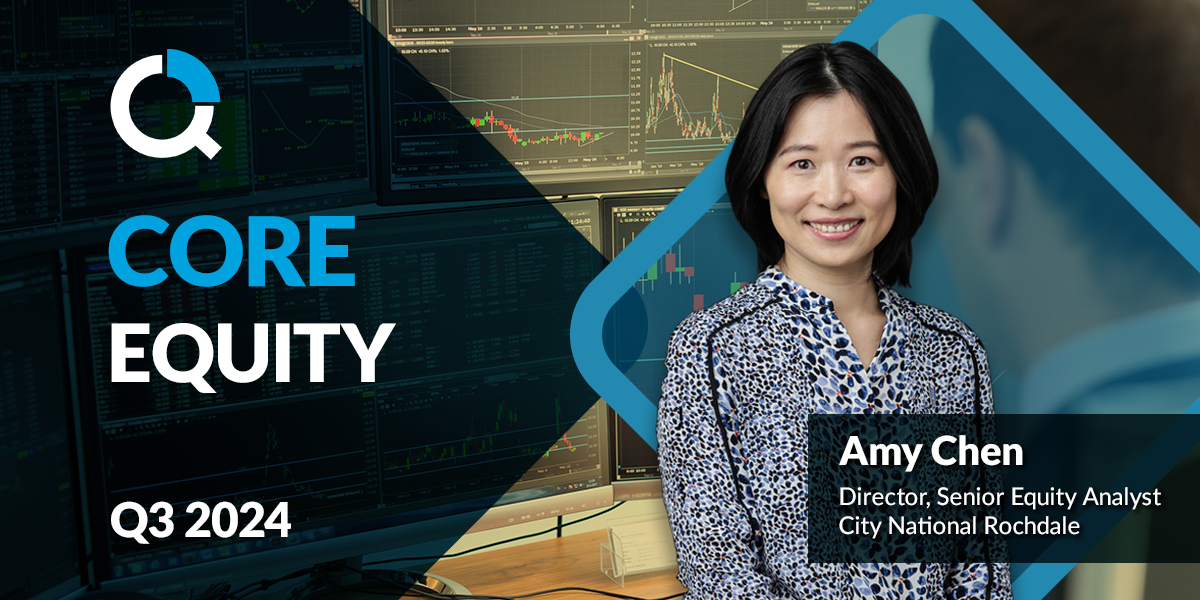
The Fed: The Fed Getting Ready to Cut Interest Rates
- The Fed is singularly focused on keeping labor growth strong.
- Inflation looks like it is headed to the Fed’s goal of a sustainable 2.0%.
- Consumer spending remains strong, but continued gains in labor are needed for it to be sustainable.
The Fed kicked off its easing cycle by going big by slashing the federal funds rate by 50 basis points instead of the 25 basis points they usually move. They opted for the more assertive approach due to the cooling labor market and high confidence that inflation is headed toward their target rate of 2.0%. The Fed is proactively trying to ease the pressure off the economy to ensure the growth in the labor market reaccelerates.
Chart 1: Federal Funds & Fed’s Longer-Term Rate
%, not seasonally adjusted
Source: Federal Reserve Bank, as of October 1, 2024.
Information is subject to change and is not a guarantee of future results.
Before the move, the federal funds rate at 5.375% was well above the Fed’s “longer term” rate of 2.5%. This is the interest rate the policymakers believe will help components of the economy (GDP, inflation, and unemployment) converge to provide maximum output and sustainably low unemployment and inflation – the rate that neither spurs nor slows economic activity. For the past two years, the Fed has kept the federal funds rate well above the longer-term rate as a restrictive monetary policy stance. It has worked, with inflation declining. The longer-term interest rate is now at 2.9%, and the Fed plans to have the federal funds rate at that level by the end of 2026, implying that the Fed will be at a neutral level.
The Fed believes their path of interest rate declines will bring about a “soft landing,” the ability to bring down inflation without causing a jump in joblessness. The Fed has not completed that task, but they have made significant progress. There is still some more work to be done. The Fed doesn’t have a set course for interest rate changes but will adjust its planned interest rate cuts based on the incoming data. The financial markets are a tad more aggressive than the Fed’s current plan for interest rate cuts in 2025. However, they are consistent with the Fed’s view by the end of 2026 (Chart 2). The financial markets appear concerned that labor growth will slowly recover in the next year.
Chart 2: Federal Funds Futures: Change from Current Level
%, as of October 1, 2024
Source: Source: Federal Reserve Bank, Bloomberg’s WIRP page as of October 2024.
Information is subject to change and is not a guarantee of future results.
Important Information
The views expressed represent the opinions of City National Rochdale, LLC (CNR) which are subject to change and are not intended as a forecast or guarantee of future results. Stated information is provided for informational purposes only, and should not be perceived as personalized investment, financial, legal or tax advice or a recommendation for any security. It is derived from proprietary and non-proprietary sources which have not been independently verified for accuracy or completeness. While CNR believes the information to be accurate and reliable, we do not claim or have responsibility for its completeness, accuracy, or reliability. Statements of future expectations,estimates, projections, and other forward-looking statements are based on available information and management’s view as of the time of these statements. Accordingly, such statements are inherently speculative as they are based on assumptions which may involve known and unknown risks and uncertainties. Actual results, performance or events may differ materially from those expressed or implied in such statements.
All investing is subject to risk, including the possible loss of the money you invest. As with any investment strategy, there is no guarantee that investment objectives will be met, and investors may lose money. Diversification may not protect against market risk or loss. Past performance is no guarantee of future performance.
There are inherent risks with equity investing. These risks include, but are not limited to stock market, manager, or investment style. Stock markets tend to move in cycles, with periods of rising prices and periods of falling prices.
There are inherent risks with fixed income investing. These risks may include interest rate, call, credit, market, inflation, government policy, liquidity, or junkbond. When interest rates rise, bond prices fall.
Bloomberg risk is the weighted average risk of total volatilities for all portfolio holdings. Total Volatility per holding in Bloomberg is ex-ante (predicted) volatility that is based on the Bloomberg factor model.
Municipal securities. The yields and market values of municipal securities may be more affected by changes in tax rates and policies than similar income-bearing taxable securities. Certain investors’ incomes may be subject to the Federal Alternative Minimum Tax (AMT), and taxable gains are also possible. Investments in the municipal securities of a particular state or territory may be subject to the risk that changes in the economic conditions of that state or territory will negatively impact performance. These events may include severe financial difficulties and continued budget deficits, economic or political policy changes, tax base erosion, state constitutional limits on tax increases and changes in the credit ratings.
City National Rochdale, LLC is an SEC-registered investment adviser and wholly-owned subsidiary of City National Bank. Registration as an investment adviser does not imply any level of skill or expertise. City National Bank is a subsidiary of the Royal Bank of Canada.
© 2024 City National Bank. All rights reserved.
Index Definitions
S&P 500 Index: The S&P 500 Index, or Standard & Poor’s 500 Index, is a market-capitalization-weighted index of 500 leading publicly traded companies in the US It is not an exact list of the top 500 US companies by market cap because there are other criteria that the index includes.
The MSCI EAFE Index is a stock market index that measures the equity market performance of developed markets outside of the U.S. & Canada.
DJ US Select Dividend Index: The Dow Jones U.S. Select Dividend Index aims to represent the U.S.’s leading stocks by dividend yield.
Bloomberg Municipal Bond Index: The Bloomberg US Municipal Bond Inde x measures the performance of in vestment grade, US dollar-denominated, long-term tax-exempt bonds.
Bloomberg Municipal High Yield Bond Inde x: The Bloomberg Municipal High Yield Bond Inde x measures the performance of noninvestment grade, US dollar-denominated, and non-r ated, tax-exempt bonds.
Bloomberg Investment Grade Index: The Bloomberg US In vestment Grade Corporate Bond Index measures the performance ofinvestment grade, corporate, fixed-rate bonds with maturities of one y ear or more.
G0BA Index: ICE BofA US Treasury Bill Index:The index measures the performance of US dollar denominated US Treasury Bills publicly issued in the US domestic market. Qualifying securities must have at least one month remaining term to final maturity and a mini mum amount outstanding of $1 billion. It is capitalization-weighted.
G0Q0 Index: ICE BofA US Treasury Index: ICE BofA US Treasury Bill Index:The index measures the performance of US dollar denominated US Treasury Bills publicly issued in the US domestic market. Qualifying securities must have at least one month remaining term to final maturity and a minimum amount outstanding of $1 bi llion. It is capitalization-weighted.
LUACTRUU Index: Bloomberg US Corporate Total Return Value Unhedged USD: The Bloomberg US Corporate Bond Index measures the investment grade, fixed-rate, taxable corporate bond market. It includes USD denominated securities publicly issued by US and non-US industrial, utility and financial issuers.
LF98TRUU Index: Bloomberg US Corporate High Yield Total Return Index Value Unhedged USD. Bloomberg: LF98TRUU Index: The Bloomberg US Corporate High Yield Bond Index measures the USD-denominated, high yield, fi xed-rate corporate bond market.
Securities are classifi ed as high yield if the middle rati ng of Moody’s, Fitch and S&P is Ba1/BB+/BB+or below. Bonds from issuers with an emerging markets country of risk, based onBloomberg EM country defi niti on, are excluded. This is the total return index level.
Indexes are unmanaged and do not reflect a deduction for fees or e xpenses. Investors cannot invest directly in an index.
Definitions
Yield to Worst (YTW) is the lower of the yield to maturity or the yield to call. It is essentially the lowest potential rate of return for a bond, excluding delinquency or default.
P/E Ratio: The price-to-earnings ratio (P/E ratio) is the ratio for valuing a company that measures its current share price relative to its earnings per share (EPS).
The 4P analysis is a proprietary framework for global equity allocation. Country rankings are derived from a subjective metrics system that combines the economic data for such countries with other factors including fiscal policies, demographics, innovative growth and corporate growth. These rankings are subjective and may be derived from data that contain inherent limitations. MSCI Emerging Markets Asia Index is a free float-adjusted market capitalization index that is designed to measure equity market performance in the Asian emerging markets.
The Magnificent Seven stocks are a group of high-performing and influential companies in the U.S. stock market: Alphabet, Amazon, Apple, Meta Platforms, Microsoft, NVIDIA, and Tesla.
City National Rochdale Proprietary Quality Ranking formula: 40% Dupont Quality (return on equity adjusted by debt levels), 15% Earnings Stability (volatility of earnings), 15% Revenue Stability (volatility of revenue), 15% Cash Earnings Quality (cash flow vs. net income of company) 15% Balance Sheet Quality (fundamental strength of balance sheet).
*Source: City National Rochdale proprietary ranking system utilizing MSCI and FactSet data. **Rank is a percentile ranking approach whereby 100 is the highest possible score and 1 is the lowest. The City National Rochdale Core compares the weighted average holdings of the strategy to the companies in the S&P 500 on a sector basis. As of September 30, 2022. City National Rochdale proprietary ranking system utilizing MSCI and FactSet data.
BPS: A basis point (BPS) is used to indicate changes in the interest rates of a financial instrument. Basis points are typically expressed with the abbreviations “bp,” “bps,” or “bips.”
A consensus estimate is a forecast of a public company’s projected earnings based on the combined estimates of all equity analysts that cover the stock.
Bureau of Labor Statistics(BLS): The BLS is a federal agency that collects and disseminates important information about labor, wages, prices, and productivity.
© 2024 City National Bank. All rights reserved.
Non-deposit investment Products are: • not FDIC insured • not Bank guaranteed • may lose value
Stay Informed.
Get our Insights delivered straight to your inbox.
More from the Quarterly Update
Put our insights to work for you.
If you have a client with more than $1 million in investable assets and want to find out about the benefits of our intelligently personalized portfolio management, speak with an investment consultant near you today.
If you’re a high-net-worth client who's interested in adding an experienced investment manager to your financial team, learn more about working with us here.




